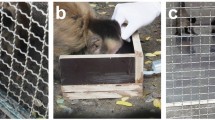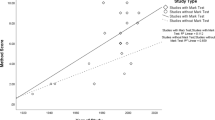Abstract
For 30 years Gallup’s (Science 167:86–87, 1970) mark test, which consists of confronting a mirror-experienced test animal with its own previously altered mirror image, usually a color mark on forehead, eyebrow or ear, has delivered valuable results about the distribution of visual self-recognition in non-human primates. Chimpanzees, bonobos, orangutans and, less frequently, gorillas can learn to correctly understand the reflection of their body in a mirror. However, the standard version of the mark test is good only for positively proving the existence of self-recognition. Conclusive statements about the lack of self-recognition are more difficult because of the methodological constraints of the test. This situation has led to a persistent controversy about the power of Gallup’s original technique. We devised a new variant of the test which permits more unequivocal decisions about both the presence and absence of self-recognition. This new procedure was tested with marmoset monkeys (Callithrix jacchus), following extensive training with mirror-related tasks to facilitate performance in the standard mark test. The results show that a slightly altered mark test with a new marking substance (chocolate cream) can help to reliably discriminate between true negative results, indicating a real lack of ability to recognize oneself in a mirror, from false negative results that are due to methodological particularities of the standard test. Finally, an evolutionary hypothesis is put forward as to why many primates can use a mirror instrumentally – i.e. know how to use it for grasping at hidden objects – while failing in the decisive mark test.








Similar content being viewed by others
References
Amsterdam B (1972) Mirror self-image reactions before age two. Dev Psychol 5:297–305
Anderson JR (1986) Mirror-mediated finding of hidden food by monkeys (Macaca tonkeana and M. fascicularis). J Comp Psychol 100:237–242
Anderson JR (1994) The monkey in the mirror: a strange conspecific. In: Parker ST, Mitchell RW, Boccia ML (eds) Self-awareness in animals and humans − developmental perspectives. Cambridge University Press, Cambridge, pp 315–329
Anderson JR (1996) Chimpanzees and capuchin monkeys: comparative cognition. In: Russon AE, Bard KA, Parker ST (eds) Reaching into thought. The minds of the great apes. Cambridge University Press, Cambridge, pp 23–56
Anderson JR (1997) Self-recognition in primates – experiments with mirrors (video tape). IWF-Knowledge and Media, Göttingen
Anderson JR, Marchal P (1994) Capuchin monkeys and confrontations with mirrors. In: Roeder JJ et al. (eds) Current primatology: social development, learning and behaviour. University Louis Pasteur Press, Strasbourg, pp 371–380
Beck B (1980) Animal tool behavior: the use and manufacture of tools by animals. Garland STPM Press, New York
Boccia ML (1994) Mirror behavior in macaques. In: Parker ST, Mitchell RW, Boccia ML (eds) Self-awareness in animals and humans – developmental perspectives. Cambridge University Press, Cambridge, pp 350–360
De Veer MW, Van den Bos R (1999) A critical review of methodology and interpretation of mirror self-recognition research in nonhuman primates. Anim Behav 58:459–468
Eglash AR, Snowdon CT (1983) Mirror-image responses in pygmy marmosets (Cebuella pygmaea). Am J Primatol 5:211–219
Gallup GG Jr (1970) Chimpanzees: self-recognition. Science 167:86–87
Gallup GG Jr (1977) Self-recognition in primates: a comparative approach to the bidirectional properties of consciousness. Am Psychol 32:329–338
Gallup GG Jr (1994) Self-recognition: research strategies and experimental design. In: Parker ST, Mitchell RW, Boccia ML (eds) Self-awareness in animals and humans – developmental perspectives. Cambridge University Press, Cambridge, pp 35–50
Gallup GG Jr, Anderson JR, Shillito DJ (2002) The mirror test. In: Bekoff M, Allen C, Burghardt GM (eds) The cognitive animal. Empirical and theoretical perspectives on animal cognition. MIT, Cambridge, pp 325–333
Gergely G (1994) From self-recognition to theory of mind. In: Parker ST, Mitchell RW, Boccia ML (eds) Self-awareness in animals and humans – Developmental perspectives. Cambridge University Press, Cambridge, pp 51–60
Guillaume P (1926/1971) Imitation in children, 2nd edn. University of Chicago Press, Chicago
Hauser MD (1997) Artifactual kinds and functional design features: what a primate understands without language. Cognition 64:285–308
Hauser MD, Kralik J, Botto-Mahan C, Garrett M, Oser J (1995) Self-recognition in primates: phylogeny and the salience of species-typical features. Proc Natl Acad Sci USA 92:10811–10814
Hauser MD, Kralik J, Botto-Mahan C (1999) Problem solving and functional design features: experiments on cotton-top tamarins, Saguinus oedipus oedipus. Anim Behav 57:565–582
Hauser MD, Miller CT, Liu K, Gupta R (2001) Cotton-top tamarins (Saguinus oedipus) fail to show mirror-guided self-exploration. Am J Primatol 53:131–137
Heyes C M (1994) Reflections on self-recognition in primates. Anim Behav 47:909–919
Inoue-Nakamura N (1997) Mirror self-recognition in non-human primates. A phylogenetic approach. Jpn Psychol Res 39:266–275
Iriki A, Tanaka M, Obayashi S, Iwamura Y (2001) Self-images in the video monitor coded by monkey intraparietal neurons. Neurosci Res 40:163–173
Ishibashi H, Hihara S, Iriki A (2000) Acquisition and development of monkey tool-use: behavioral and kinematic analyses. Can J Physiol Pharmacol 78:958–966
Itakura S (1987) Use of a mirror to direct their responses in Japanese monkeys (Macaca fuscata fuscata). Primates 28:343–352
Lehner PP (1996) Handbook of ethological methods. Cambridge University Press, Cambridge
Lewis M, Brooks-Gunn J (1979) Social cognition and the acquisition of self. Plenum, New York
Liebal K, Pika S, Tomasello M (2004) Social communication in siamangs (Symphalangus syndactylus): use of gestures and facial expressions. Primates 45:41–57
McGrew W (1992) Chimpanzee material culture. Cambridge University Press, New York
Meltzoff AN (1990) Foundations for developing a concept of self. In: Cicchetti D, Beeghly M (eds) The self in transition: infancy to childhood. University of Chicago Press, Chicago, pp 139–164
Mendes N, Huber L (2004) Object permanence in common marmosets (Callithrix jacchus). J Comp Psychol 118:103–112
Menzel EW Jr, Savage-Rumbaugh ES, Lawson J (1985) Chimpanzee problem solving with the use of mirrors and televised equivalents of mirrors. J Comp Psychol 99:211–217
Missler M, Wolff JR, Rothe H (1992) Developmental biology of the common marmoset: proposal for a postnatal staging. J Med Primatol 21:285–298
Mitchell RW (1993) Mental models of mirror self-recognition: two theories. New Ideas Psychol 11:295–325
Mitchell RW (2005) Mirrors and matchings: imitation from the perspective of mirror-self-recognition. In: Dautenhahn K, Nehaniv C (eds) Imitation and social learning in robots, humans and animals. Cambridge University Press, Cambridge
Obayashi S, Suhara T, Kawabe K, Okauchi T, Maeda J, Akine Y, Onoe H, Iriki A (2001) Functional brain mapping of monkey tool use. NeuroImage 14:853–861
Parker ST (1991) A developmental approach to the origins of self-recognition in great apes. Hum Evol 6:435–449
Piaget J (1952) Origins of intelligence in children. Norton, New York
Posada S, Colell M (2005) Mirror responses in a group of Miopithecus talapoin. Primates 46:165–172
Povinelli DJ (1989) Failure to find self-recognition in Asian elephants (Elephas maximus) in contrast to their use of mirror cues to discover hidden food. J Comp Psychol 102:122–131
Povinelli DJ, Cant JGH (1995) Arboreal clambering and the evolution of self-conception. Q Rev Biol 70:393–421
Povinelli DJ, Rulf AB, Landau KR, Bierschwale DT (1993) Self-recognition in chimpanzees: distribution, ontogeny, and patterns of emergence. J Comp Psychol 107:347–372
Schrader L, Todt D (1993) Contact call parameter covary with social context in common marmosets, Callithrix jacchus. Anim Behav 46:1026–1028
Stevenson MF, Poole TB (1976) An ethogram of the common marmoset (Callithrix jacchus): general behavioural repertoire. Anim Behav 24:428–451
Swartz KB, Sarauw D, Evans S (1999) Comparative aspects of mirror self-recognition in great apes. In: Parker ST, Mitchell RW, Miles HL (eds) The mentalities of gorillas and orangutans. Cambridge University Press, Cambridge, pp 283–294
Ujhelyi M, Merker B, Buk P, Geissmann T (2000) Observations on the behavior of gibbons (Hylobates leucogenys, H. gabriellae and H. lar) in the presence of mirrors. J Comp Psychol 114:253–262
Voelkl B, Huber L (2000) True imitation in marmosets. Anim Behav 60:195–202
Werdenich D, Huber L (2002) Social factors determine cooperation in marmosets. Anim Behav 64:771–781
Zeller A (2002) Pretending in primates. In: Mitchell RW (ed) Pretending and imagination in animals and children. Cambridge University Press, Cambridge, pp 183–195
Acknowledgements
We wish to thank Anne Zeller for reading the rough draft of the manuscript and Robert Mitchell and two anonymous referees for giving valuable comments on all aspects of the study. While conducting this work, we complied with the ethical standards in the treatment of the animals as stated in the guidelines laid down by the EC Guide for animal experiments. This research was made possible by a grant of the Konrad Lorenz Institute, Altenberg, Austria. The costs of the experimental facilities (Vivarium) were financed by the government of Lower Austria.
Author information
Authors and Affiliations
Corresponding author
Additional information
To see a video sequence of the instrumental use of mirror by Callithrix jacchus as described in this study, please go to http://www.kli.ac.at/personal/heschl/film.html
About this article
Cite this article
Heschl, A., Burkart, J. A new mark test for mirror self-recognition in non-human primates. Primates 47, 187–198 (2006). https://doi.org/10.1007/s10329-005-0170-8
Received:
Accepted:
Published:
Issue Date:
DOI: https://doi.org/10.1007/s10329-005-0170-8




